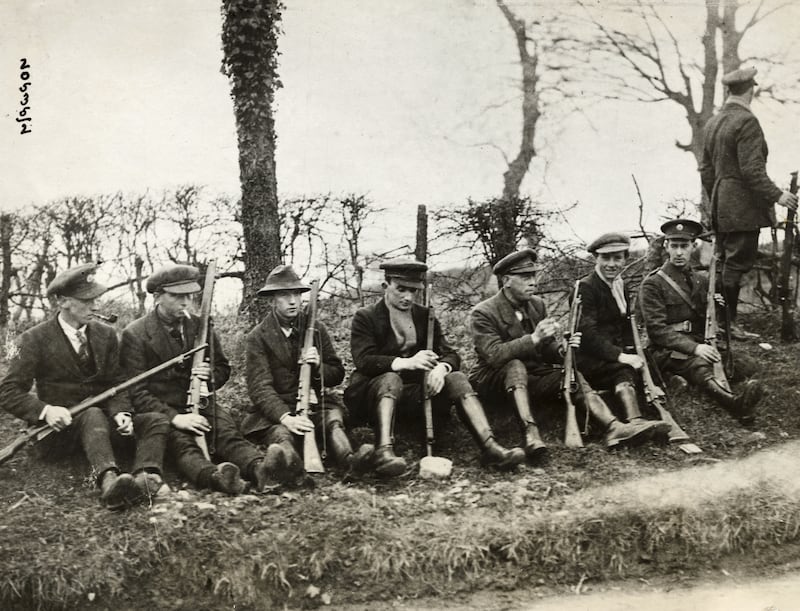The Civil War Christmas of 1922 prompted writer George Russell (AE) to pen a letter to The Irish Times to plead with the anti-Treaty IRA to end the conflict: “The certitude of the soul that its ideal is right too often begets a moral blindness with regard to conduct, and its purity of motive is taken as absolution for its sins.” It was a good summary of the Civil War mentalities on both sides. Russell insisted: “There is no dishonour in raising the conflict from the physical to the intellectual plane.”
But some of the horrors of 1923 had to be endured first and for cultural nationalists such as Russell who wanted to foster intellectual debate to harness what they saw as the great potential of the State and its people, the challenges were often overwhelming.
Trying to occupy a critical position between the demands of politics and art could be an exhaustive endeavour, and in 1923 Russell bemoaned that Free State Ireland had “hardly deflected a hair’s breadth from the old cultural lines” because violence had squandered the poetic and artistic spirit.
Young Cork writers Frank O’Connor and Seán O’Faoláin initially embraced the anti-Treaty IRA cause in 1922, but it grew wearisome. For O’Connor, too many mythical abstractions reduced life to “a tedious morality”, while Ó Faoláin was later to record that the civil war “woke us up from the mesmerism of the romantic dream. It set us asking questions ... about the pre-sanctified dogmas of our history. We were blessed by a series of writers who had the courage to face experience and record it.”
READ MORE
One of them was playwright Seán O’Casey. April next year marks the centenary of the first staging of the Shadow of a Gunman at the Abbey Theatre. The controversy aroused by O’Casey’s dramas while the conflict was still so raw was often visceral, as he raised fundamental questions about violence and challenged the founding myths of the new State. Another of his plays, Juno and the Paycock, was set during the Civil War in 1922 and he later suggested one of its core messages was that “We should be careful of personal idealism; good as it may be and well meaning, its flame in a few hearts may not give new life and new hope to the many, but dwindle into ghastly and futile funeral pyres.”

For some critics, his depiction of aspects of the interior of the revolution and its failure to transform the lives (or housing) of the Dublin tenement dwellers was an unacceptable disparagement.
We need to acknowledge and atone for the wrongs that were done on all sides, so we can finally heal the wounds and scars from that time
— Leo Varadkar on Civil War
Hanna Sheehy Skeffington railed against his irreverence, insisting the tensions his work exposed were between “the Ireland that remembers with tear-dimmed eyes” the republican sacrifice, and “the Ireland that forgets, that never knew”. Her anger was understandable – her husband Frank had been murdered in 1916 – but it was another of those sweeping pious assertions that simplified the contours of memory, the role of artists and the politics of commemoration.
Those complexities remain relevant. In taking up the office of Taoiseach again last week, Leo Varadkar suggested, regarding the centenary of the Civil War: “We need to acknowledge and atone for the wrongs that were done on all sides, so we can finally heal the wounds and scars from that time, and find an appropriate way of ending a century of hurt on both sides, allowing us to finally move to reconciliation.”
It will be interesting to see how or whether that is tackled. It will not be about neat resolution; nor does it need to be. What is marked by the State in the form of “official” remembrance combines, sometimes uneasily, with academic history, cultural and artistic representations, local initiative and personal and folk memories. These are often shaped and altered by the needs of the present.

Back in 1998, American historian Richard White reflected on the difference between his mother’s stories of the 1798 rebellion and academic history and he concluded: “History is the enemy of memory ... history forges weapons from what memory has forgotten or suppressed ... but there are regions of the past that only memory knows ... there is nothing my mother has told me that is without some basis in the past. But neither, at least in those cases where I can recover the historical scraps, is there a story that to a historian sifting through the evidence clearly happened as she remembered.”
[ Bertie Ahern says lessons to be learned from studying Civil WarOpens in new window ]
And for those who lived through conflict and upheaval in Ireland, other preoccupations endured, even in the dark years. This newspaper recorded that Christmas Day in Dublin in 1922 was “unexpectedly peaceful”; in the run-up, the streets “were thronged with shoppers” and there was a “great influx of visitors” to the country. For Christmas Eve and Christmas Day “the guns were silent” and for the Christmas Day plunge into the icy sea at the 40 Foot in Sandycove, “there was a record attendance”.














